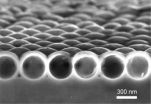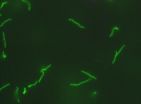(Press-News.org) BUFFALO, N.Y. -- Parkinson's disease researchers at the University at Buffalo have discovered how mutations in the parkin gene cause the disease, which afflicts at least 500,000 Americans and for which there is no cure.
The results are published in the current issue of Nature Communications.
The UB findings reveal potential new drug targets for the disease as well as a screening platform for discovering new treatments that might mimic the protective functions of parkin. UB has applied for patent protection on the screening platform.
"This is the first time that human dopamine neurons have ever been generated from Parkinson's disease patients with parkin mutations," says Jian Feng, PhD, professor of physiology and biophysics in the UB School of Medicine and Biomedical Sciences and the study's lead author.
As the first study of human neurons affected by parkin, the UB research overcomes a major roadblock in research on Parkinson's disease and on neurological diseases in general.
The problem has been that human neurons live in a complex network in the brain and thus are off-limits to invasive studies, Feng explains.
"Before this, we didn't even think about being able to study the disease in human neurons," he says. "The brain is so fully integrated. It's impossible to obtain live human neurons to study."
But studying human neurons is critical in Parkinson's disease, Feng explains, because animal models that lack the parkin gene do not develop the disease; thus, human neurons are thought to have "unique vulnerabilities."
"Our large brains may use more dopamine to support the neural computation needed for bipedal movement, compared to quadrupedal movement of almost all other animals," he says.
Since in 2007, when Japanese researchers announced they had converted human cells to induced pluripotent stem cells (iPSCs) that could then be converted to nearly any cells in the body, mimicking embryonic stem cells, Feng and his UB colleagues saw their enormous potential. They have been working on it ever since.
"This new technology was a game-changer for Parkinson's disease and for other neurological diseases," says Feng. "It finally allowed us to obtain the material we needed to study this disease."
The current paper is the fruition of the UB team's ability to "reverse engineer" human neurons from human skin cells taken from four subjects: two with a rare type of Parkinson's disease in which the parkin mutation is the cause of their disease and two healthy subjects who served as controls.
"Once parkin is mutated, it can no longer precisely control the action of dopamine, which supports the neural computation required for our movement," says Feng.
The UB team also found that parkin mutations prevent it from tightly controlling the production of monoamine oxidase (MAO), which catalyzes dopamine oxidation.
"Normally, parkin makes sure that MAO, which can be toxic, is expressed at a very low level so that dopamine oxidation is under control," Feng explains. "But we found that when parkin is mutated, that regulation is gone, so MAO is expressed at a much higher level. The nerve cells from our Parkinson's patients had much higher levels of MAO expression than those from our controls. We suggest in our study that it might be possible to design a new class of drugs that would dial down the expression level of MAO."
He notes that one of the drugs currently used to treat Parkinson's disease inhibits the enzymatic activity of MAO and has been shown in clinical trials to slow down the progression of the disease.
Parkinson's disease is caused by the death of dopamine neurons. In the vast majority of cases, the reason for this is unknown, Feng explains. But in 10 percent of Parkinson's cases, the disease is caused by mutations of genes, such as parkin: the subjects with Parkinson's in the UB study had this rare form of the disease.
"We found that a key reason for the death of dopamine neurons is oxidative stress due to the overproduction of MAO," explains Feng. "But before the death of the neurons, the precise action of dopamine in supporting neural computation is disrupted by parkin mutations. This paper provides the first clues about what the parkin gene is doing in healthy controls and what it fails to achieve in Parkinson's patients."
He noted in this study that these defects are reversed by delivering the normal parkin gene into the patients' neurons, thus offering hope that these neurons may be used as a screening platform for discovering new drug candidates that could mimic the protective functions of parkin and potentially even lead to a cure for Parkinson's.
While the parkin mutations are only responsible for a small percentage of Parkinson's cases, Feng notes that understanding how parkin works is relevant to all Parkinson's patients. His ongoing research on sporadic Parkinson's disease, in which the cause is unknown, also points to the same direction.
INFORMATION:
In addition to Feng, co-authors are Houbo Jiang, PhD, Yong Ren, PhD, Eunice Y. Yuen, all research assistant professors at UB; Ping Zhong, PhD, research scientist, Mahboobe Ghaedi, PhD, postdoctoral associate, Zhixing Hu, PhD, postdoctoral associate, and Zhen Yan, PhD, professor, all of the UB Department of Physiology and Biophysics. Other co-authors are Gissou Azabdaftari, MD, of the Roswell Park Cancer Institute, and Kazuhiro Nakaso, MD, of Tottori University in Japan.
END
The aviation accident attorneys at Baum, Hedlund, Aristei & Goldman are representing the families of the two men killed in Robinson Helicopter Company's first R66 crash which occurred on July 12, 2011 near Flandes, Colombia.
Jose Ricardo Cabrera Killed in the crash, was the owner of the R66 aircraft, Juan Pablo Gaviria, former president of the Colombian Civil Air Patrol, and Jose Ricardo Cabrera, his dear friend and a skilled helicopter pilot.
The R66 crashed shortly after take-off from Girardot Airport in Colombia. According to the National Transportation Safety ...
HOUSTON -- (Feb. 8, 2012) -- A protein kinase known as ROCK1 can exacerbate an important process called fission in the mitochondria, the power plants of cells, leading to diabetic kidney disease, said researchers from Baylor College of Medicine in a report that appears online today in the journal Cell Metabolism. (ROCK1 stands for (Rho-associated coiled-coil containing protein kinase 1.)
"We have shown the connection between ROCK1 and the progression to kidney disease through the effect of ROCK1 on the mitochondria," said Dr. Farhad R. Danesh, association professor ...
Visitors to Statuary Hall in the U.S. Capitol Building may have experienced a curious acoustic feature that allows a person to whisper softly at one side of the cavernous, half-domed room and for another on the other side to hear every syllable. Sound is whisked around the semi-circular perimeter of the room almost without flaw. The phenomenon is known as a whispering gallery.
In a paper published in Nature Communications, a team of engineers at Stanford describes how it has created tiny hollow spheres of photovoltaic nanocrystalline-silicon and harnessed physics to do ...
While epilepsy surgery is a safe and effective intervention for seizure control, medical therapy remains the more prominent treatment option for those with epilepsy. However, a new 26-year study reveals that following epilepsy surgery, nearly half of participants were free of disabling seizures and 80% reported better quality of life than before surgery. Findings from this study—the largest long-term study to date—are now available in Epilepsia, a journal published by Wiley-Blackwell on behalf of the International League Against Epilepsy (ILAE).
More than 50 million ...
###
Additional authors on the study include: Elie Ghanem, MD and Bahar Adeli, BA, both with the Rothman Institute at Jefferson.
About Thomas Jefferson University Hospitals
Thomas Jefferson University Hospitals (TJUH) are dedicated to excellence in patient care, patient safety and the quality of the healthcare experience. Consistently ranked by U.S. News & World Report among the nation's top hospitals, Thomas Jefferson University Hospital, established in 1825, has over 900 licensed acute care beds with major programs in a wide range of clinical specialties. ...
Patients who have their anterior cruciate ligament (ACL) reconstructed by surgeons who have performed less than 60 surgeries are roughly four to five times more likely to undergo a subsequent ACL reconstruction, according to a study by researchers at Hospital for Special Surgery. The study also showed that participating in a subspecialty orthopedic fellowship-training program did not improve the learning curve of young surgeons performing ACL reconstructions. The research was presented at the annual meeting of the American Academy of Orthopedic Surgeons, held Feb 7-11.
"Conventional ...
Complex systems are prone to communication breakdowns, unless there is a concerted effort to properly share necessary information. Unfortunately, the failure to communicate is all too prevalent in the delivery of medical care.
Dr. Peter Pronovost, a leading patient-safety experts at Johns Hopkins University, estimates diagnostic errors are responsible for the deaths of 40,000 to 80,000 hospitalized patients every year. That is a shockingly high number.
With so many errors being made, injured people naturally turn to the legal system seeking proper compensation. And ...
Geneva, Switzerland: The first European Clinical Practice Guidelines (CPGs) for the diagnosis and management of Wilson's disease are published today by the European Association for the Study of the Liver (EASL) on the EASL website -- www.easl.eu.(1) Developed to assist physicians and healthcare providers in the clinical decision making process, the guidelines describe best practice for the diagnosis and treatment of patients with Wilson's disease -- a rare genetic(2) disorder that, if left untreated, is fatal.
Approximately one in 30,000 people worldwide are affected ...
Stripping some mouth bacteria of their access key to gangs of other pathogenic oral bacteria could help prevent gum disease and tooth loss. The study, published in the journal Microbiology suggests that this bacterial access key could be a drug target for people who are at high risk of developing gum disease.
Oral bacteria called Treponema denticola frequently gang up in communities with other pathogenic oral bacteria to produce destructive dental plaque. This plaque, made up of bacteria, saliva and food debris, is a major cause of bleeding gums and gum disease. Later ...
It appears that Arizona Governor Janet Brewer's attempt to block the imposition of Proposition 203 has come to an end. Last week, a Maricopa County judge dismissed the lawsuit that sought to block the portion of the law that allowed state-run marijuana dispensaries. According to a report by the Arizona Republic, Superior Court judge Richard Gama ruled that the state did not have any discretion in whether the voter-supported initiative could proceed.
The law, named the Arizona Medicinal Marijuana Act (AMMA) legalizes marijuana use for people with chronic or debilitating ...


